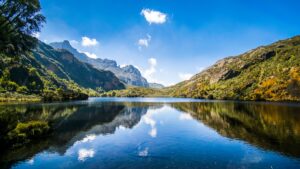Rwenzori Mountains National Park
The Rwenzori Mountains commonly known as the ‘Mountains of the Moon’ lie in western Uganda along the Uganda Congo border. The snow Peaks are the third highest point in Africa while the lower slopes are blanketed in Moreland, bamboo and rich moist Montane forest. This national park harbors 70 mammals and 217 bird species like the 19 Albertine rift endemics as well as some of the world’s rarest vegetation. These mountains are also a world class hiking and mountaineering destination. This trek takes nine to twelve days for skilled climbers to the summit of Margherita, the highest peak through shorter non technical treks.
 AREAS OF INTEREST
AREAS OF INTEREST
Lakes
This national park has over 20lakes with Lake Mahoma being the lowest and most accessible and its rich in birds. The beautiful Lake Bujuku lies at the head of the deep, glacier carved Bujuku valley in the shadow of Mounts Stanley, Baker and Speke. Ascended by the Kilembe trail in the Nyamwamba valley, dams created by glacial moraine have created a string of eight delightful lakes. Several rivers and streams originate from the mountain, forming lifelines for the flora in the flood plains.
Equatorial snow peaks
The high Rwenzori mountain comprises six distinct mountains with mount Stanley (5109m) located just miles north of the equator being the highest, Speke (4,890m) and Baker (4,843m) – all bear permanent snow and glaciers. The snow peaks can be reached by hiking the Central Circuit and Kilembe Trails.
Land of the Triffids
The misty, boggy, glacier-carved valleys of the high Rwenzori form a strange botanical world inhabited by triffid-sized forms of lobelia, heather and groundsel, crisp “everlasting flowers,” garishly colored mosses and gnarled trees draped with curtains of lichen. The result is an otherworldly setting which has been compared to the forests of the Jabberwock, the Seven Dwarves and inevitably, Tolkien’s Middle Earth. These strange plants rank among the world’s botanical treasures, being found only on the highest mountains of East Africa.
Ruboni and Bulema
Ruboni is the trail head for the seven day central circuit to the high peaks and it’s found at the south eastern foot of the Rwenzori mountains. It is also the starting point for hill walks, birding and nature walks through the traditional homesteads of the local Bakonzo community. The remains of the Rwenzururu kings house at Bulema.
VEGETATION
This park is commonly known for its amazing and distinctive plants other than the fauna. Hikers climb through a series of distinct altitudinal vegetation zones, Montane scenarios and lobelia on their way to the peaks. Bamboo, afro alpine, Montane senecio and tree heathers are also present along the tracks.
BIRDING
This park is a home to 217 bird species including various rift endemics and among them are the 17 species that are endemic to the park making Rwenzori an important birding area. At 1800, this zone contains numerous bird species like Rwenzori Turacpo, handsome francolin, white starred robin, long eared owl, strange weaver, and various species like barbets, greenbul, apalises, flycatchers and crimson wings.
WILDLIFE
70 species of mammals are harbored in this parks thick forests and some of them include the elephant, Rwenzori otter, leopard, and chimpanzees. These thick forests also make spotting of wildlife so hard and primates like colobus and blue monkeys are in there as well. Other available mammals are small antelopes, bush bucks, unusual reptiles like the three horned chameleon.
ACTIVITIES
Hiking and nature walks
The central circuit provides an opportunity to the nature walks and these include trails up to lake Mahooma and Buraro chimp forest. Hikes to Bundibugo area through Bwamba pass. The Ruboni and Turaco communities offer guided forest walks of various lengths outside the park. Tourists can follow the River Mubuku, and glimpse views of Baker and Portal Peaks as they hike up to 2,300m above sea level. The snow capped Margherita peak can also be seen on a clear day. Chameleons, vervet monkeys, squirrels and other birds are also seen.
Birding
The Montane forest is good for bird watching with 217 bird species that choose to make it their home. These include bee eaters, sunbirds, robins, and barbets. Other species to watch out for are the Rwenzori Turaco and Long-eared Owl; while higher up on the slopes, Bearded Vultures, Swifts and Black Eagles may be seen circling for prey.
Mountain climbing
This challenge can be completed with two different trails. These include the centrail circuit trail and the Kilembe trail.
The central circuit trail is a seven day climb that gives a circular tour of the Rwenzori Mountains. From the trailhead at Mihunga, the route ascends the Bujuku Valley via Nyabitaba for acclimatization before reaching the peaks. Visitors joining the Central Circuit after Bujuku will traverse the Scott Elliot and Fresh field passes to descend through the Mubuku Valley. Hikers can scale the snow peaks though many consider the exceptional scenery ample reward for their exertions.
The Kilembe trail ascends the south slopes of the mountain from Kilembe near Kasese town. The route along the lovely Nyamwamba Valley passes glacial lakes and some stunning viewpoints before joining the Central Circuit at Lake Kitandara. The standard route scales Mount Baker though the scenery makes shorter treks rewarding enough. Tourists can book through Rwenzori Mountaineering Services (RMS) and Rwenzori Trekking Services (RTS)
ACCOMODATION
Accommodation in this park is found in many places like Ruboni were we find Ruboni community camp, geo lodges quarter snow and Ruboni turaco camp. In Kilembe, we have the trekkers’ hostel while in Nyakalegyiya we have the Rwenzori mountains safari lodge. All these offer services to the tourists.
